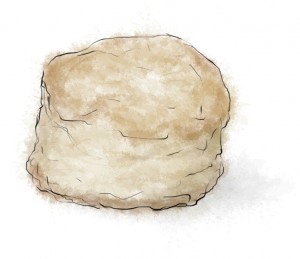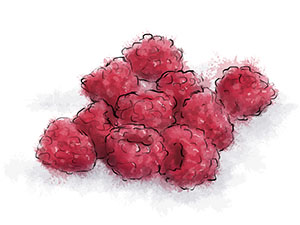When it comes to matters pastry-related, who better to turn to for advice than a grandma, and I have, in my opinion, the very best grandma to give it.
She’s been making scones for church coffee mornings, for jumble sales and for her friends for over 70 years. A consummate stealth cook, a visitor dropping in sometime between lunch and dinner will rarely leave un-fed.
“I can’t stop. I only came to drop off the Mission Boxes.â€
Grandma, vanishing into the kitchen; “You’ve got time for a cup of tea?â€
“No. I’m alright, Molly. I’ll best be off.â€
“Half a cup then. And you’ll have a little something to eat?â€
“Honestly Molly, I can’t stop.â€
Grandma, bustling out of the kitchen with a tray; “Here’s your tea. And I’ve made you a little sandwich. Just a little one. And a scone.â€
Visitor, sitting down by the fire with a look of contentment; “Ooh, lovely. Thank you.â€
When I think of her, I can smell the butter.
Scones, jam and cream
Grandma tells me that she uses an egg and milk because the egg gives the scones a cake-y texture. If you prefer a less cake-y texture she gives you permission to use an extra tbsp full of milk instead.
She uses a combination of half butter, half trex, which is vegetable shortening. Apparently she initially did this because it was cheaper than all butter, but later discovered it made the scones much lighter and softer.
2 cups of flour ¼ cup of sugar 2 tsp baking powder (check the date on your tub – if it’s not well in date there’s really no point) 1/3 cup of fat – a 50:50 mixture of unsalted butter and vegetable shortening (fridge cold) 1 egg ½ cup of milk- Pre heat the oven to 375
- Cut the butter and lard into cubes
- Tip the dry ingredients into a bowl and add the fat
- Using your fingertips (r a food processor on pulse) rub the fat into the flour mixture until it resembles breadcrumbs
- Add the egg and mix gently with a metal spoon (or pulse once of twice in the processor) – you really don’t want to over mix now, or the glutens I the flour will develop and you’ll get rock hard scones
- Add the milk a spoonful at a time until the mixture comes together – you might not need all of it
- Tip onto a floured board and roll out (grandma uses a roll of tin foil so she can rip off the layer and save on washing up)
- Use a floured cutter or a the rim of a glass to cut out the scones. Use a twisting rather than a pressing motion – it seems to make them rise better
- Brush the tops with milk or egg
- Bake for 15 – 18 minutes, depending on the size of the scone
Raspberry jam
 Raspberries have a fair bit of pectin in them, so they’re one of the easier jams to get a good texture on. I make my jam by weighing a few handful of berries, adding the same weight of sugar and cooking the two together on a low heat with a good squeeze of lemon juice for about 20 minutes. Jon likes his jam spoonable and thick. I prefer mine fairly runny, but if I’m making it for him, I add half a grated (peeled) granny smith apple. The pectin in the apple helps the raspberries to set. I keep my jam for a couple of weeks in the fridge.
Raspberries have a fair bit of pectin in them, so they’re one of the easier jams to get a good texture on. I make my jam by weighing a few handful of berries, adding the same weight of sugar and cooking the two together on a low heat with a good squeeze of lemon juice for about 20 minutes. Jon likes his jam spoonable and thick. I prefer mine fairly runny, but if I’m making it for him, I add half a grated (peeled) granny smith apple. The pectin in the apple helps the raspberries to set. I keep my jam for a couple of weeks in the fridge.
Nigella Lawson has a great recipe for raspberry jam – it’s a very cool method and I recommend it if you want something a bit more formal than mine;
- Heat an oven to 350
- Pour one cup of raspberries and one cup of sugar onto 2 pie dishes
- Cook for 20 – 25 mins
- Combine the hot contents of the dishes – instant jam
Cream
Clotted cream is the idea. Whipped cream sweetened with some vanilla sugar is lovely. It’s sometimes hard to find clotted cream here in New York , so I’ve been using this recipe that I found on joyofbaking.com, for “fake†clotted cream. It’s good. It has the right texture and tastes smooth and rich and delicious.
4oz marscapone 1 cup cream 1 tsp good vanilla 1 tsp sugar- Whip the ingredients into a thick cream







4 Responses to Scones, Jam and Cream